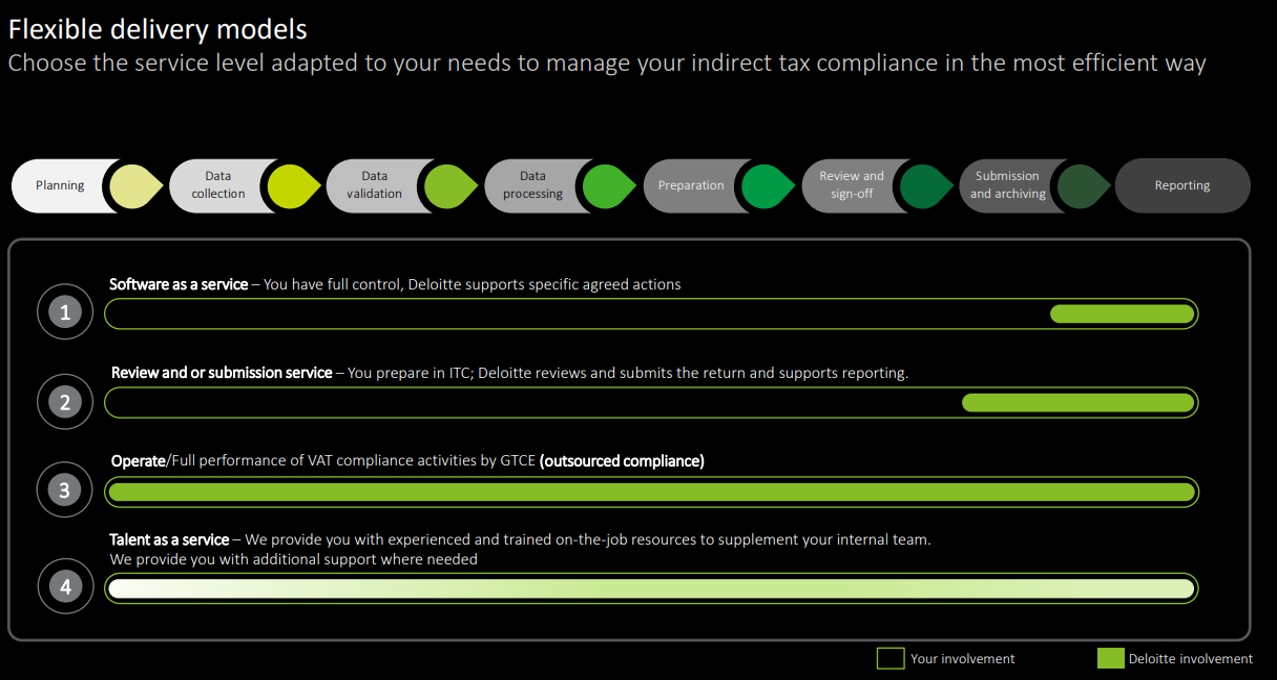Article

Centralising global indirect tax compliance
In our Deloitte Global Tax Centers, we achieve centralised preparation of returns using our global digital solution, Deloitte indirect compliance tool (ITC) which is a single application to streamline reporting, get valuable data insights, and improve efficiency, while keeping risks under control.
Our global indirect operating model is used to deliver services via three specific methods that recognise the degree of our clients’ desired centralisation. Generally, indirect compliance is delivered and managed locally in our Deloitte local offices. However, we are seeing a shift in the marketplace toward coordinated and centralised delivery, which provides increased visibility, process efficiencies, and risk mitigation.
In our Deloitte Global Tax Centers, we achieve centralised preparation of returns using our global digital solution, Deloitte indirect compliance tool (ITC). This tool is a single application to streamline reporting, get valuable data insights, and improve efficiency, while keeping risks under control.
New digital reporting requirements and greater scrutiny from tax authorities are challenging businesses to find more efficient, automated, and potentially more centralised ways to manage their indirect tax compliance process. Tax departments are required to achieve more with less, while still facing challenges from multiple data sources, varying data quality, numerous processes, and country-specific requirements.
Combining our tax knowledge and expertise in technology, Deloitte has developed an industry-leading cloud solution, Deloitte ITC, to address these challenges. Deloitte ITC supports the end-to-end compliance process, from automated data extraction to the electronic submission of returns where required. Today, the application covers more than 75 countries globally.
In the intricate landscape of the Asia Pacific (APAC) region, each country has its own unique set of indirect tax rules, regulations, and reporting requirements. Managing compliance across these varying jurisdictions can be complex and time-consuming. Centralised delivery using Deloitte ITC empowers businesses to navigate these complexities by providing a unified platform to effectively handle diverse compliance obligations.
The adoption of centralised compliance delivery in the APAC region offers numerous advantages. One key benefit is the ability to standardise processes and data across different countries. The tool enforces consistent compliance activities, reducing errors that may arise from manual calculations and reporting. This minimises the risk of non-compliance due to misinterpretation or misapplication of local regulations.
Additionally, the tool's automation features greatly enhance efficiency. Automating the process of generating compliance returns reduces the reliance on manual efforts, allowing internal teams to focus on more strategic or advisory tasks. Automation also minimises the chances of missing deadlines, which helps to avoid penalties and maintains a positive relationship with tax authorities.
Centralised compliance delivery also provides enhanced visibility and control. The tool offers insights into the organisation's compliance obligations across multiple APAC countries. This visibility enables the central team to monitor compliance, identify potential issues, and make informed decisions based on accurate data. The tool's reporting capabilities also allow organisations to analyse trends, optimise processes, and proactively addresses discrepancies. In Deloitte, we can offer flexible delivery models using Deloitte ITC as shown below:

Successful implementation requires collaboration among various internal teams. The central team responsible for managing the indirect tax tool should work closely with finance, tax, and Information Technology (IT) departments to ensure smooth integration, data accuracy, and ongoing support.
In conclusion, centralised delivery of indirect tax compliance for the APAC region offers numerous benefits. This approach leverages automation, standardisation, and enhanced visibility to ensure accurate and consistent compliance reporting across diverse jurisdictions. By embracing modern technology and centralising compliance efforts, organisations can navigate the complexities of APAC compliance regulations more effectively while optimising efficiency and reducing compliance-related risk.
For further information, please contact Richard Mackender and Mark Koh.
